The Impact of Different Winter Cover Crops on Weed Suppression and Corn Yield under Different Tillage Systems
Abstract
1. Introduction
2. Materials and Methods
2.1. Experiment Site Description
2.2. Experiment and Treatment Design
2.3. Farming Manege
2.4. Crop Yield and Weeds Biomass
2.5. Data Collection
2.6. Statistical Analysis
3. Results
3.1. Corn Yield and Weed Biomass
3.2. Continuous Monitoring of Vegetation Coverage after Cover Crop Sowing
3.3. Effect of Cover Crops and Tillage Systems on the Growth of Corn
3.4. Effect of Cover Crop Straw Returning Back to the Field on Growth of Corn
3.4.1. Straw Return on Seedling Morphological Properties
3.4.2. Effect of Straw Return on Physiological Characteristics of Corn
- Effect of straw return on protective enzyme activity and MDA content of corn.
- 2.
- Effect of straw return on chlorophyll- and photosynthesis-related properties of corn.
4. Discussion
5. Conclusions
Supplementary Materials
Author Contributions
Funding
Data Availability Statement
Acknowledgments
Conflicts of Interest
References
- Tesio, F.; Ferrero, A. Allelopathy, a chance for sustainable weed management. Int. J. Sustain. Dev. World Ecol. 2010, 17, 377–389. [Google Scholar] [CrossRef]
- Qaswar, M.; Huang, J.; Ahmed, W.; Li, D.C.; Liu, S.J.; Ali, S.; Liu, K.L.; Xu, Y.M.; Zhang, L.; Liu, L.S.; et al. Long-term green manure rotations improve soil biochemical properties, yield sustainability and nutrient balances in acidic paddy soil under a rice-based cropping system. Agronomy 2019, 9, 780. [Google Scholar] [CrossRef]
- Martínez-Mena, M.; Carrillo-López, E.; Boix-Fayos, C.; Almagro, M.; García Franco, N.; Díaz-Pereira, E.; Montoya, I.; De Vente, J. Long-term effectiveness of sustainable land management practices to control runoff, soil erosion, and nutrient loss and the role of rainfall intensity in Mediterranean rainfed agroecosystems. Catena 2020, 187, 104352. [Google Scholar] [CrossRef]
- Seidel, E.P.; Caetano, J.H.S.; Karpinski, A.S.; Reis, W.D. Residual dry matter, weeds and soil aggregates after winter cover crop. J. Exp. Agric. Int. 2019, 32, 1–11. [Google Scholar] [CrossRef]
- Scavo, A.; Mauromicale, G. Crop allelopathy for sustainable weed management in agroecosystems: Knowing the present with a view to the future. Agronomy 2021, 11, 2104. [Google Scholar] [CrossRef]
- Mushtaq, M.N.; Cheema, Z.A.; Khaliq, A.; Naveed, M.R. A 75% reduction in herbicide use through integration with sorghum + sunflower extracts for weed management in wheat. J. Sci. Food Agric. 2010, 90, 1897–1904. [Google Scholar] [CrossRef]
- Restuccia, A.; Scavo, A.; Lombardo, S.; Pandino, G.; Fontanazza, S.; Anastasi, U.; Abbate, C.; Mauromicale, G. Long-term effect of cover crops on species abundance and diversity of weed flora. Plants 2020, 9, 1506. [Google Scholar] [CrossRef]
- Yamane, K.; Kono, M.; Taiji, F.; Iwai, K.; Sekine, R.; Watanabe, Y.; Iijima, M. Field evaluation of coffee grounds application for crop growth enhancement, weed control, and soil improvement. Plant Prod. Sci. 2014, 17, 93–102. [Google Scholar] [CrossRef]
- Mishchenko, Y.G.; Masik, I.M. Control of soil weediness and sugar beets by after crop green manure and different tillages. Ukr. J. Ecol. 2017, 7, 517–524. [Google Scholar] [CrossRef][Green Version]
- Carlesi, S.; Bigongiali, F.; Antichi, D.; Ciaccia, C.; Tittarelli, F.; Canali, S.; Bàrberi, P. Green manure and phosphorus fertilization affect weed community composition and crop/weed competition in organic maize. Renew. Agric. Food Syst. 2020, 35, 493–502. [Google Scholar] [CrossRef]
- Frabboni, L.; Tarantino, A.; Petruzzi, F.; Disciglio, G. Bio-herbicidal effects of oregano and rosemary essential oils on chamomile (Matricaria chamomilla L.) crop in organic farming system. Agronomy 2019, 9, 475. [Google Scholar] [CrossRef]
- Carolina, G.P.; Rui, F.G.; Patrícia, V.; Paula, B.A.; Manuel, J.R.; Nuria, P. The consistency between phytotoxic effects and the dynamics of allelochemicals release from Eucalyptus globulus leaves used as bioherbicide green manure. J. Chem. Ecol. 2018, 44, 658–670. [Google Scholar]
- Mangao, A.M.; Arreola, S.L.B.; San, G.E.V.; Salamanez, K.C. Aqueous extract from leaves of Ludwigia hyssopifolia (G. Don) exell as potential bioherbicide. J. Sci. Food Agric. 2020, 100, 1185–1194. [Google Scholar] [CrossRef] [PubMed]
- Anderson, R.L. Suppressing weed growth after wheat harvest with underseeded red clover in organic farming. Renew. Agric. Food Syst. 2015, 31, 185–190. [Google Scholar] [CrossRef]
- Barnes, J.P.; Putnam, A.R. Role of benzoxazinones in allelopathy by rye (Secale cereale L.). J. Chem. Ecol. 1987, 13, 889–906. [Google Scholar] [CrossRef]
- Reberg-Horton, C.S.; Burton, J.D.; Danehower, D.A.; Guoying, M.A.; Monks, W.D.; Murphy, J.P.; Ranells, N.N.; John, D.W.; Creamer, G.N. Changes over time in the allelochemical content of ten cultivars of rye (Secale cereale L.). J. Chem. Ecol. 2005, 31, 179–193. [Google Scholar] [CrossRef]
- Ismail, B.S.; Siddique, A.B.; Tayeb, M.A. Phytotoxic effects of the aqueous extract of Ludwigia hyssopifolia (G. Don) exell on the growth of rice seedlings. In Proceedings of the 2nd International Conference on Agriculture, Environment and Biological Sciences, Bali, Indonesia, 16–17 August 2015; pp. 31–32. [Google Scholar]
- Anitha, S.; Mathew, J.; Abraham, C.T. Concurrent growing of green manure with wet-seeded rice for cost-effective weed management. Indian J. Weed Sci. 2012, 44, 34–37. [Google Scholar]
- Travlos, I.S.; Kanatas, P.J.; Tsioros, S.; Papastylianou, P.; Papatheohari, Y.; Bilalis, D. Green manure and pendimethalin impact on oriental sun-cured tobacco. Agron. J. 2014, 106, 1225–1230. [Google Scholar] [CrossRef]
- IUSS Working Group. World Reference Base for Soil Resources 2006, 2nd ed.; Food and Agriculture Organization: Rome, Italy, 2006. [Google Scholar]
- Goharrizi, K.J.; Meru, G.; Ghotbzadeh, K.S.; Heidarinezhad, A.; Salehi, F. Short-term cold stress affects physiological and biochemical traits of pistachio rootstocks. S. Afr. J. Bot. 2021, 141, 90–98. [Google Scholar] [CrossRef]
- Xiao, F.; Zhao, Y.; Wang, X.R.; Liu, Q.; Ran, J. Transcriptome analysis of needle and root of Pinus massoniana in response to continuous drought stress. Plants 2021, 10, 769. [Google Scholar] [CrossRef]
- Scavo, A.; Restuccia, A.; Abbate, C.; Lombardo, S.; Fontanazza, S.; Pandino, G.; Anastasi, U.; Mauromicale, G. Trifolium subterraneum cover cropping enhances soil fertility and weed seedbank dynamics in a Mediterranean apricot orchard. Agron. Sustain. Dev. 2021, 41, 70. [Google Scholar] [CrossRef]
- Scavo, A.; Restuccia, A.; Lombardo, S.; Fontanazza, S.; Abbate, C.; Pandino, G.; Anastasi, U.; Onofri, A.; Mauromicale, G. Improving soil health, weed management and nitrogen dynamics by Trifolium subterraneum cover cropping. Agron. Sustain. Dev. 2020, 40, 18. [Google Scholar] [CrossRef]
- Matsuoka, T.; Asagi, N.; Komatsuzaki, M. Response of weeds and rice yield to Italian ryegrass as a cover crop and planting density in organic farming. Agron. J. 2021, 114, 689–699. [Google Scholar] [CrossRef]
- Yang, H.; Wu, G.; Mo, P.; Chen, S.; Wang, S.; Xiao, Y.; Ma, H.A.; Wen, T.; Guo, X.; Fan, G. The combined effects of maize straw mulch and no-tillage on grain yield and water and nitrogen use efficiency of dry-land winter wheat. Soil Tillage Res. 2020, 197, 104485. [Google Scholar] [CrossRef]
- Ping, L.; Yin, H.L.; Zhong, Q.Y.; Yan, P.X.; Fei, T.; Xu, D.J.; Miao, W.; De Rong, X.; Xi, Z.W. Effects of application of corn straw on soil microbial community structure during the maize growing season. J. Basic Microb. 2015, 55, 22–32. [Google Scholar]
- Zhuang, Y.; Zhao, D.G.; Zhao, Y.C. Effect of water extract of cotton roots on allelopathy in Citrullus lanatus and Glycine max. Seed 2019, 38, 24–29. [Google Scholar]
- Vasilakoglou, I.; Dhima, K.; Anastassopoulos, E.; Lithourgidis, A.; Gougoulias, N.; Chouliaras, N. Oregano green manure for weed suppression in sustainable cotton and corn fields. Weed Biol. Manag. 2011, 11, 38–48. [Google Scholar] [CrossRef]
- Shi, Y.Z.; Cui, Y.L.; Wang, L.; Cai, S.; Yu, S. Regulation of nitrogen-phosphorus and Chinese milk vetch improve canopy characteristics and yield of early season rice. Trans. Chin. Soc. Agric. Eng. 2014, 30, 89–97. [Google Scholar]
- Muñoz, J.D.; Finley, A.O.; Gehl, R.; Kravchenko, S. Nonlinear hierarchical models for predicting cover crop biomass using normalized difference vegetation index. Remote Sens. Environ. 2010, 114, 2833–2840. [Google Scholar] [CrossRef]
- Kumar, V.; Brainard, D.C.; Bellinder, R.R.; Hahn, R.R. Buckwheat residue effects on emergence and growth of weeds in winter-wheat (Triticum aestivum) cropping systems. Weed Sci. 2011, 59, 567–573. [Google Scholar] [CrossRef]
- Shirtliffe, S.; Johnson, E. Progress towards no-till organic weed control in western Canada. Renew. Agric. Food Syst. 2012, 27, 60–67. [Google Scholar] [CrossRef]
- Baldivieso-Freitas, P.; Blanco-Moreno, J.; Armengot, L.; Chamorro, L.; Romanyà, J.; Sans, F. Crop yield, weed infestation and soil fertility responses to contrasted ploughing intensity and manure additions in a Mediterranean organic crop rotation. Soil Tillage Res. 2018, 180, 10–20. [Google Scholar] [CrossRef]
- Naeem, M.; Farooq, M.; Farooq, S.; Ul-Allah, S.; Alfarraj, S.; Hussain, M. The impact of different crop sequences on weed infestation and productivity of barley (Hordeum vulgare L.) under different tillage systems. Crop Prot. 2021, 149, 105759. [Google Scholar] [CrossRef]
- Lorena, Á.; Puig, C.G.; Revilla, P.; Reigosa, M.J.; Pedrol, N. Faba bean as green manure for field weed control in maize. Weed Res. 2018, 58, 437–449. [Google Scholar]
- Puig, C.G.; Lorena, Á.; Reigosa, M.J.; Pedrol, N. Eucalyptus globulus leaves incorporated as green manure for weed control in maize. Weed Sci. 2013, 61, 154–161. [Google Scholar] [CrossRef]
- Thomsen, M.G.; Brandsæter, L.O.; Fykse, H. Sensitivity of Cirsium arvense to simulated tillage and competition. Acta Agric. Scand. Sect. B Soil Plant Sci. 2011, 61, 693–700. [Google Scholar]
- Gangadharan, S.; Chinnamuthu, C.R. Effect of nutrient management and green manure inter cropping on weed dynamics of direct seeded red rice. Adv. Life Sci. 2016, 5, 1670–1675. [Google Scholar]
- Feledyn-Szewczyk, B.; Smagacz, J.; Kwiatkowski, C.A.; Harasim, E.; Woźniak, A. Weed flora and soil seed bank composition as affected by tillage system in three-year crop rotation. Agriculture 2020, 10, 186. [Google Scholar] [CrossRef]
- Cheng, W.G.; Okamoto, Y.; Takei, M.; Tawaraya, K.; Yasuda, H. Combined use of Azolla and loach suppressed weed Monochoria vaginalis and increased rice yield without agrochemicals. Org. Agric. 2015, 5, 1–10. [Google Scholar] [CrossRef]
- Tang, S.; Wang, Y.Q.; Zhang, Z.; Wu, L.M.; Huang, J.; Cao, W.D. Effects of multi-year milk vetch application on weed seedbank density and biodiversity in paddy field. Chin. J. Ecol. 2016, 35, 1730–1736. [Google Scholar]
- Bishal, B.; Sagar, D. Cementing the organic farming by green manures. Int. J. Appl. Sci. Biotechnol. 2018, 6, 87–96. [Google Scholar]
- Wulanningtyas, H.S.; Gong, Y.; Li, P.; Sakagami, N.; Nishiwaki, J.; Komatsuzaki, M. A cover crop and no-tillage system for enhancing soil health by increasing soil organic matter in soybean cultivation. Soil Tillage Res. 2021, 205, 104749. [Google Scholar] [CrossRef]
- Puig, C.G.; Revilla, P.; Barreal, M.E.; Reigosa, M.J.; Pedrol, N. On the suitability of Eucalyptus globulus green manure for field weed control. Crop Prot. 2019, 121, 57–65. [Google Scholar] [CrossRef]
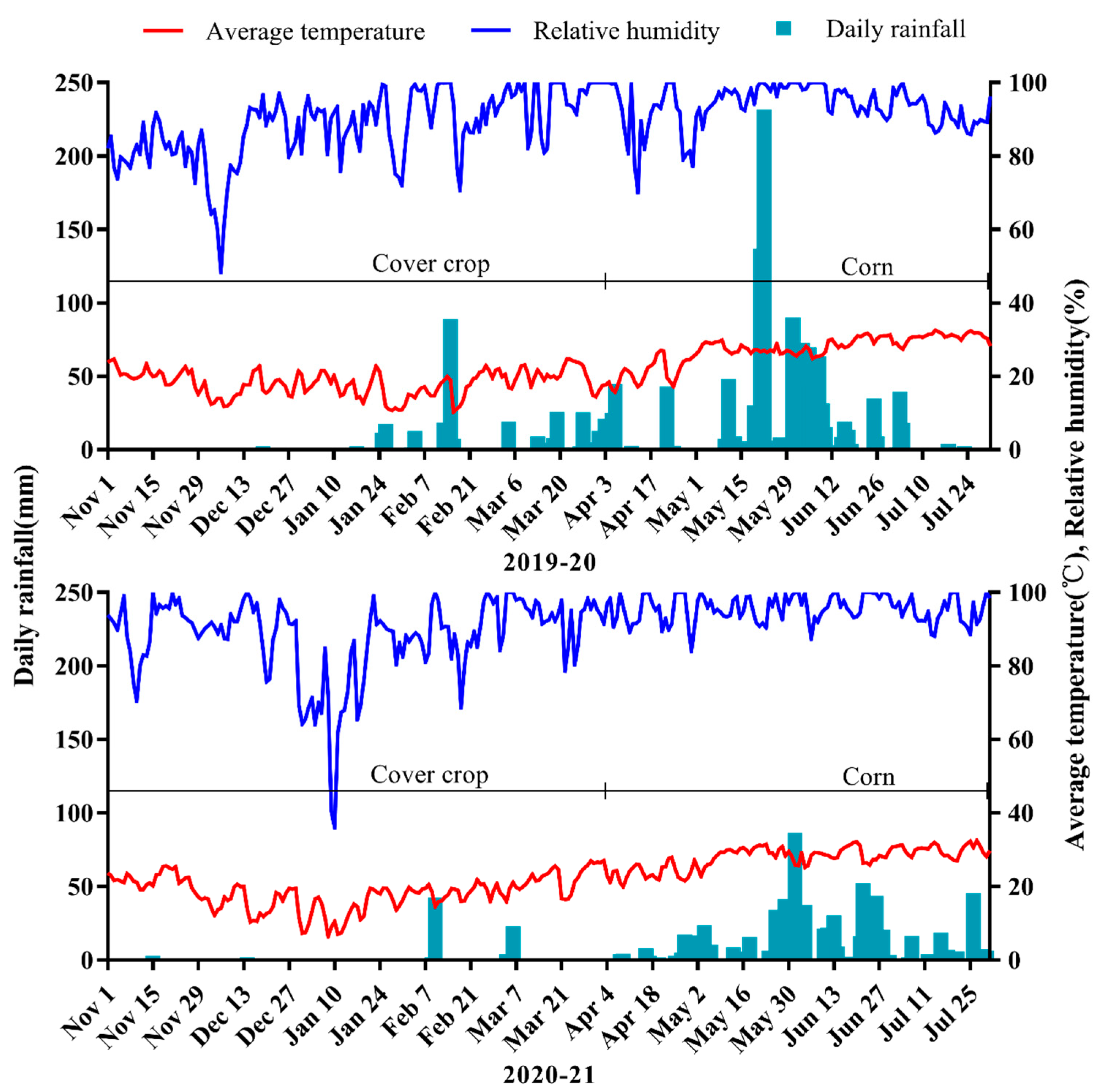
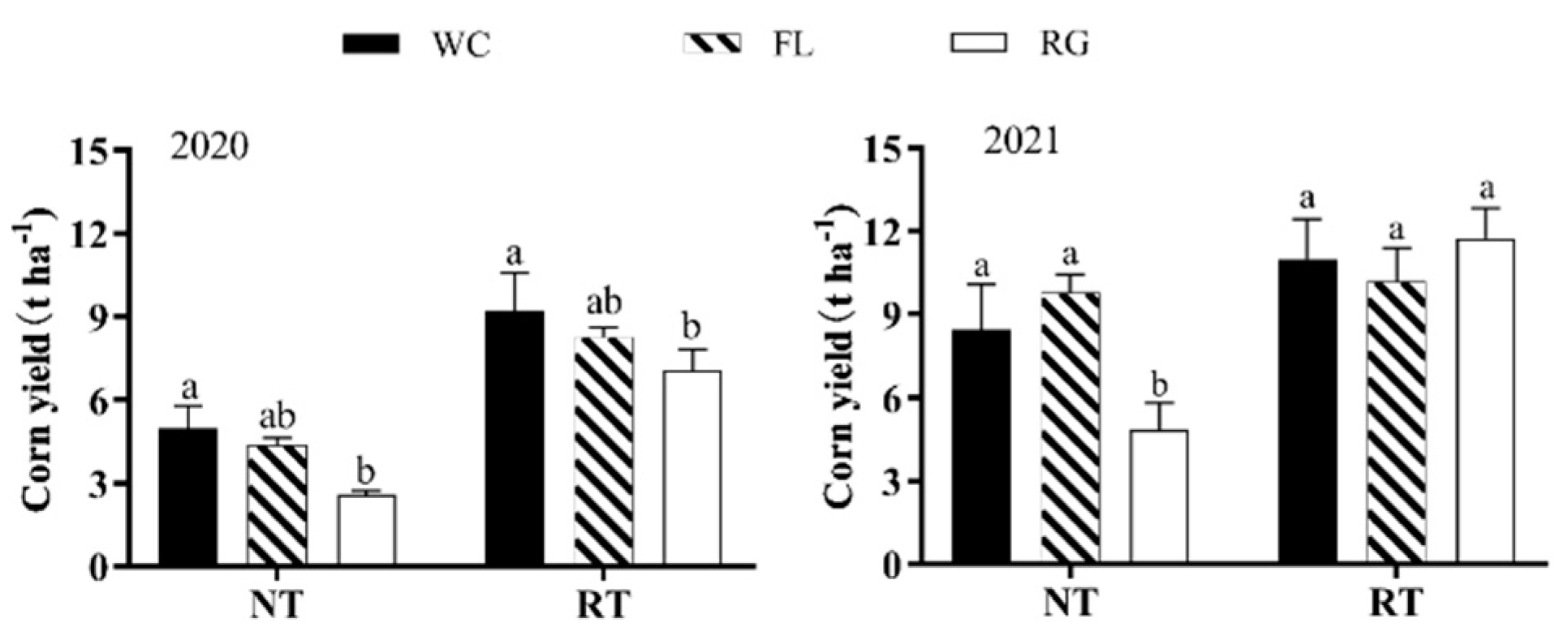
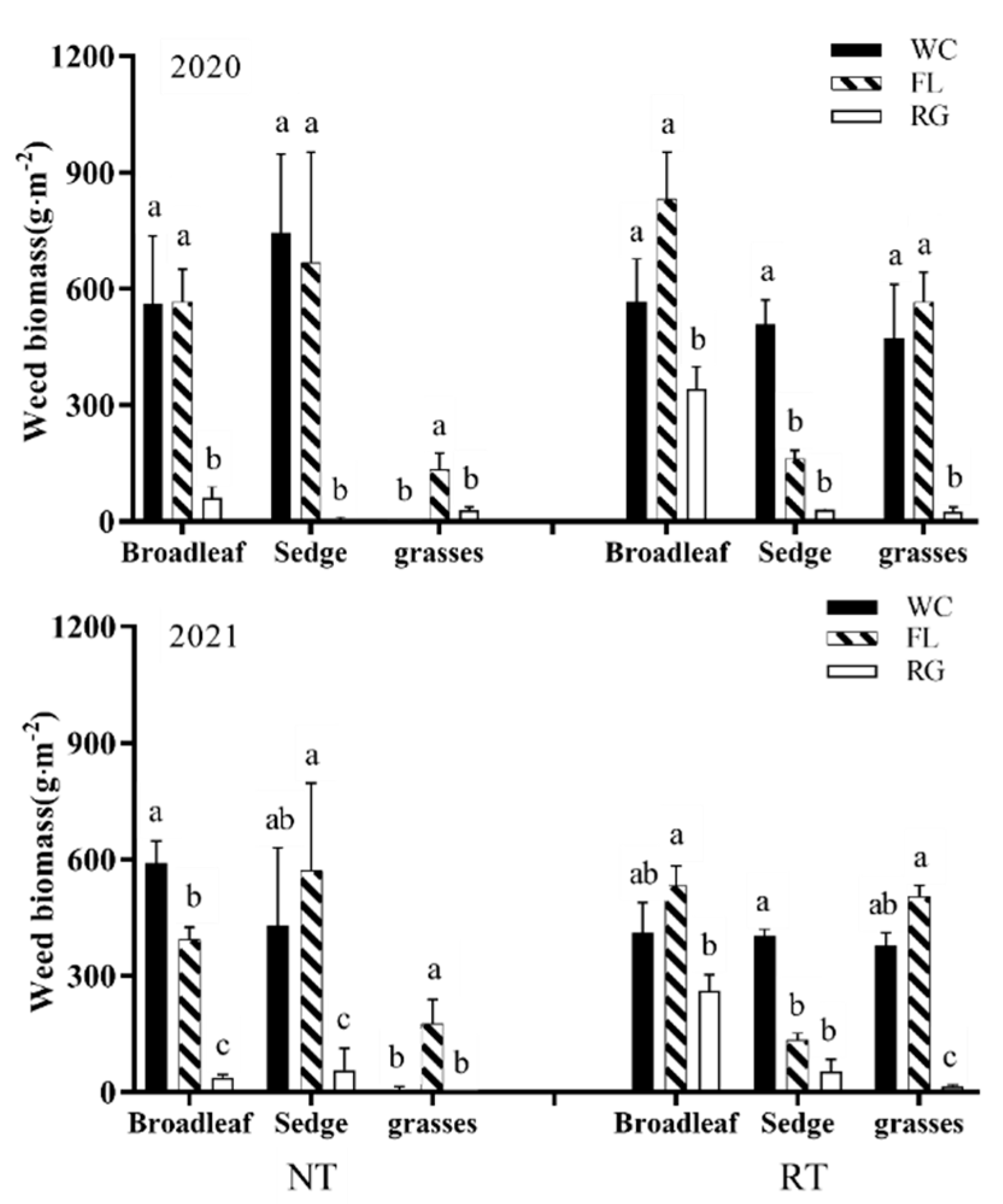
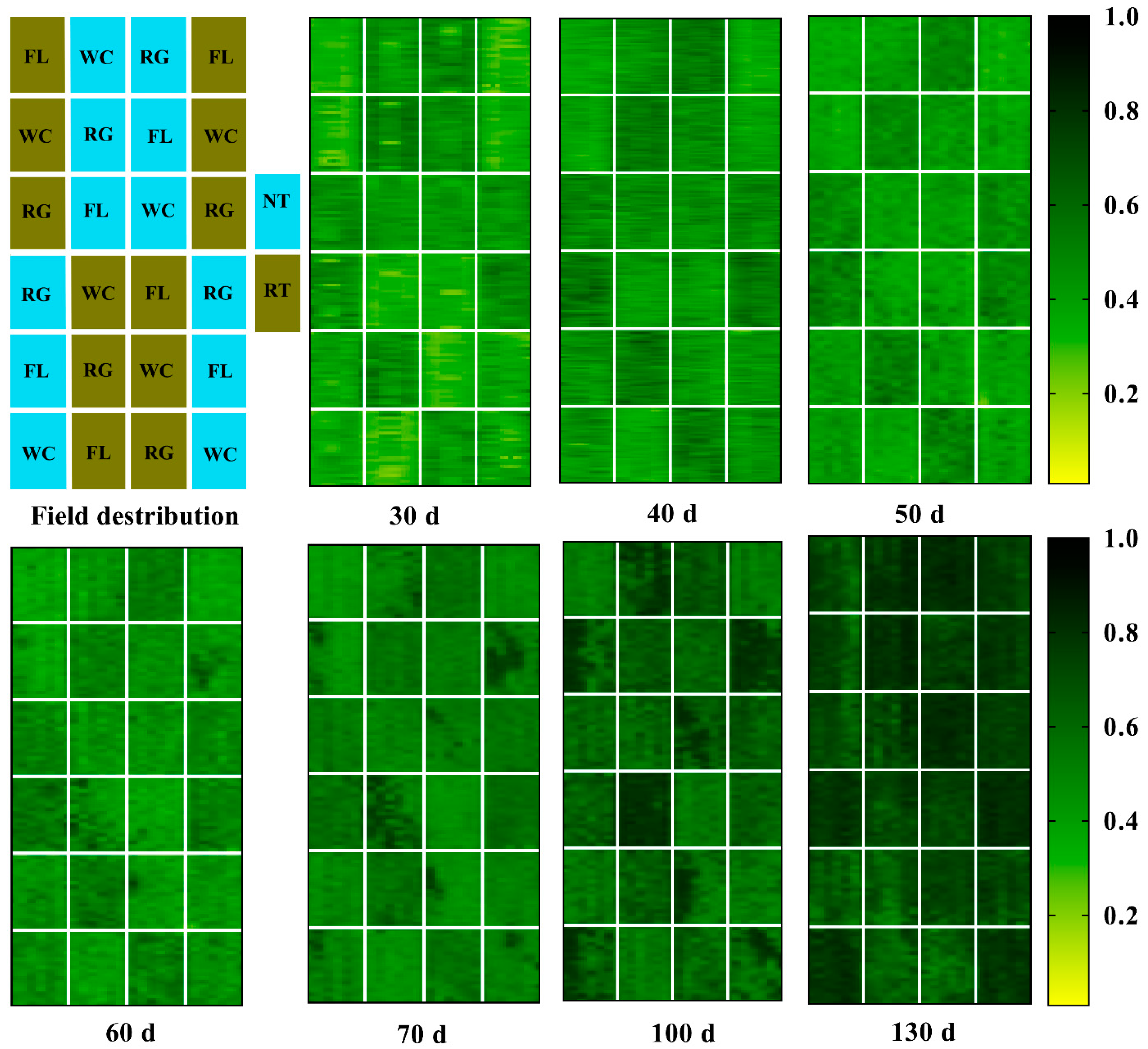
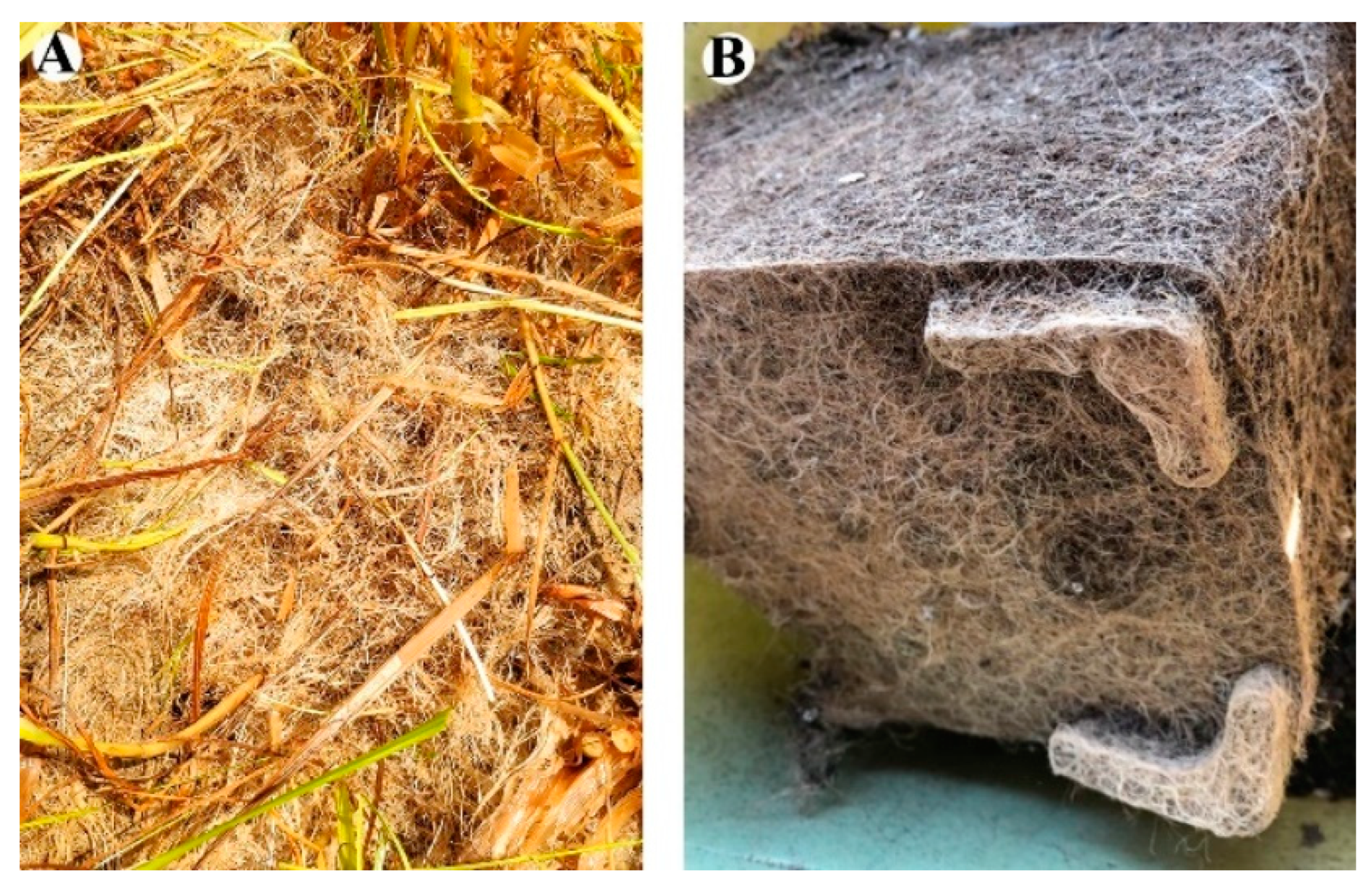


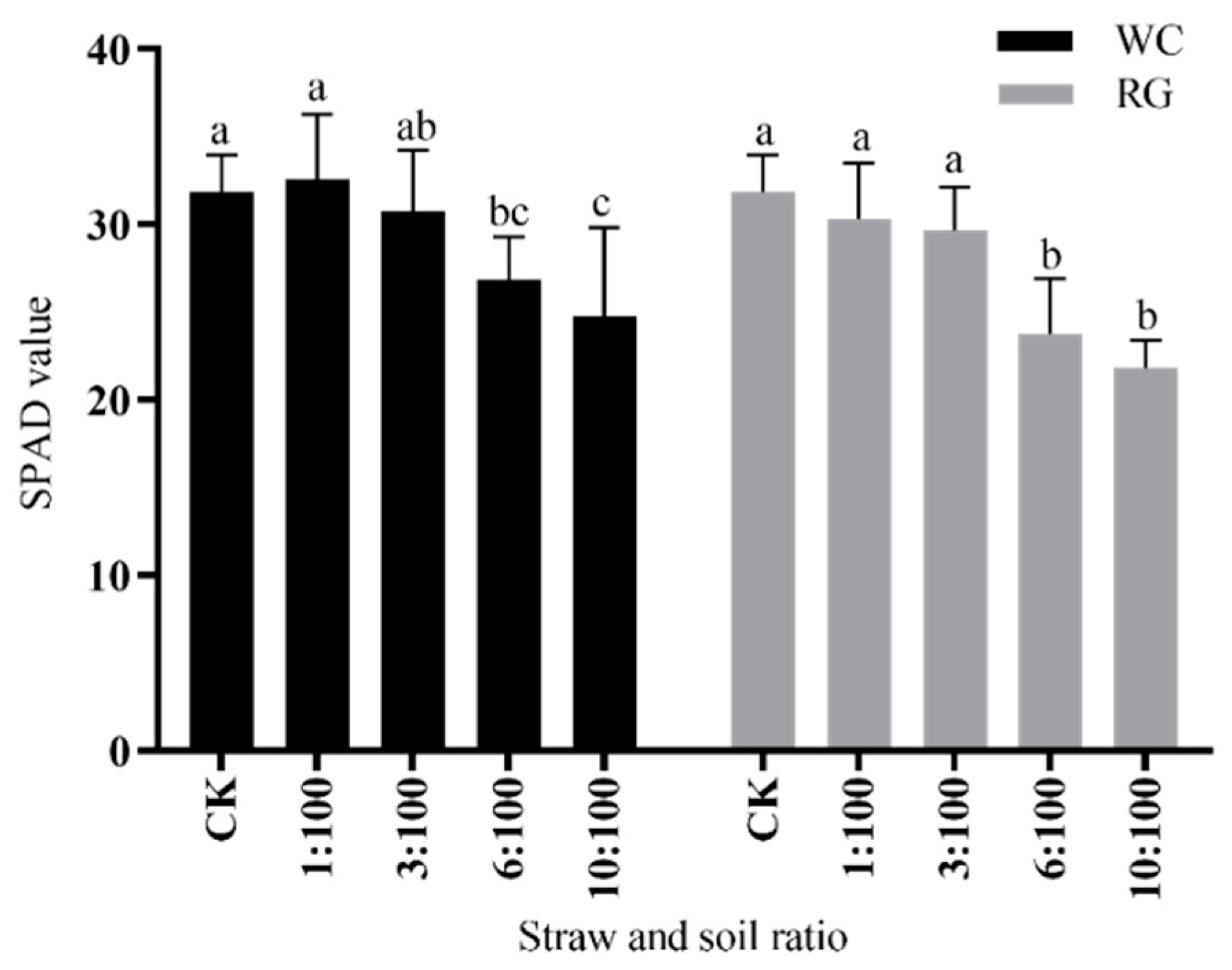
| Cover Crop Biomass (t ha−1) | Weed Biomass (t ha−1) | Corn Yield (t ha−1) | ||||
|---|---|---|---|---|---|---|
| 2020 | 2021 | 2020 | 2021 | 2020 | 2021 | |
| Tillage | ||||||
| NT | 8.26 | 17.09 a | 7.63 b | 5.78 b | 3.98 b | 7.69 b |
| RT | 7.04 | 11.78 b | 11.18 a | 8.80 a | 8.05 a | 10.66 a |
| T | ns | ** | * | ** | *** | ** |
| Cover Crop | ||||||
| WC | 8.10 | 32.67 a | 12.12 a | 9.91 a | 7.06 a | 9.70 a |
| RG | 9.10 | 7.88 b | 2.24 b | 1.84 b | 4.82 b | 7.82 b |
| FL | 6.23 | 4.59 b | 13.86 a | 10.11 a | 6.33 a | 9.99 a |
| CC | ns | *** | *** | *** | *** | *** |
| Interaction | ||||||
| T × CC | ns | ns | *** | ns | ns | *** |
| Treatment | Plant Height (m) | Stem Diameter (mm) | Panicle Weight (kg) | Barren Ear Tip (mm) | SPAD Value | Economic Coefficient |
|---|---|---|---|---|---|---|
| NT-WC | 1.25 (0.094) a | 15.08 (1.84) b | 0.22 (0.041) b | 18.77 (3.02) ab | 51.03 (2.12) b | 0.56 (0.028) ab |
| NT-FL | 1.27 (0.080) a | 16.23 (1.09) ab | 0.26 (0.017) ab | 16.96 (2.50) c | 54.31 (1.92) a | 0.55 (0.013) ab |
| NT-RG | 1.06 (0.10) b | 11.37 (0.72) c | 0.13 (0.025) c | 23.54 (6.93) a | 45.32 (2.82) c | 0.55 (0.021) ab |
| RT-WC | 1.30 (0.074) a | 18.27 (1.18) a | 0.29 (0.040) a | 16.72 (2.35) c | 55.40 (1.55) a | 0.52 (0.024) b |
| RT-FL | 1.25 (0.061) a | 16.90 (1.17) ab | 0.27 (0.033) ab | 13.91 (3.56) c | 55.08 (1.58) a | 0.57 (0.024) a |
| RT-RG | 1.35 (0.10) a | 18.40 (2.07) a | 0.29 (0.025) a | 15.41 (0.53) c | 56.00 (1.88) a | 0.53 (0.039) ab |
| LSD value | T = 0.01, CC = 0.23 | T = 0.00, CC = 0.04 | T = 0.00, CC = 0.01 | T = 0.01, CC = 0.12 | T = 0.00, CC = 0.01 | T = 0.36, CC = 0.23 |
| T × CC = 0.01 | T × CC = 0.00 | T × CC = 0.00 | T × CC = 0.24 | T × CC = 0.00 | T × CC = 0.07 |
| Treatment | Total Length (cm) | Average Diameter (mm) | Surface Area (cm2) | Volume (cm3) | Branch Points | Root Tips | Root Activity (μg·g−1) |
|---|---|---|---|---|---|---|---|
| CK | 695.51 (176.11) b | 6.70 (0.34) b | 131.43 (19.37) c | 6.03 (1.66) b | 3827.00 (621.30) c | 5081.60 (441.25) c | 1.90 (0.011) e |
| WC 1:100 | 977.47 (145.46) a | 8.00 (0.26) a | 258.18 (27.39) a | 12.84 (2.10) a | 5976.25 (733.56) b | 8273.40 (945.04) a | 3.30 (0.0080) b |
| WC 3:100 | 1092.56 (45.51) a | 8.10 (0.29) a | 283.08 (15.28) a | 13.03 (3.24) a | 6605.00 (334.08) b | 6923.00 (1537.07) ab | 6.00 (0.02) a |
| WC 6:100 | 1151.40 (117.28) a | 5.80 (0.058) c | 205.67 (21.49) b | 7.28 (1.26) b | 7503.40 (749.19) a | 6895.40 (1248.09) ab | 2.20 (0.01) d |
| WC 10:100 | 1041 (116.41) a | 6.90 (0.14) b | 225.15 (27.07) b | 8.69 (1.22) b | 6249.80 (1325.17) b | 6500.60 (1377.52) bc | 2.70 (0.023) c |
| CK | 695.51 (176.11) c | 6.70 (0.34) a | 131.43 (19.37) b | 6.03 (1.66) c | 3827.00 (621.30) c | 5081.60 (441.25) b | 1.90 (0.011) d |
| RG 1:100 | 938.85 (92.10) b | 6.60 (0.46) a | 195.61 (12.64) a | 8.33 (0.99) a | 6105.00 (591.51) a | 5519.00 (895.1) b | 3.80 (0.021) a |
| RG 3:100 | 1140.94 (75.59) a | 5.70 (0.060) b | 204.50 (11.22) a | 7.37 (1.19) ab | 6917.80 (500.36) a | 9357.50 (1723.64) a | 2.60 (0.020) b |
| RG 6:100 | 1127.63 (114.68) a | 5.90 (0.27) b | 212.24 (20.74) a | 8.85 (1.23) a | 6724.25 (583.18) a | 8793.75 (1913.43) a | 2.50 (0.021) c |
| RG 10:100 | 974.30 (93.14) b | 6.00 (0.29) b | 196.96 (24.67) a | 7.72 (1.39) ab | 5215.00 (553.67) b | 5792.25 (1141.54) b | 1.60 (0.0080) e |
| Treatment | Pn (μmol·m−2·s−1) | E (μmol·m−2·s−1) | Gtc (μmol·m−2·s−1) | Ci (μmol·mol−1) | iWUE (μmol·mmol−1) |
|---|---|---|---|---|---|
| CK | 16.93 (3.63) d | 1.48 (0.20) d | 66.61 (10.13) c | 125.88 (28.89) ab | 11.37 (1.09) c |
| WC 1:100 | 20.6 (2.45) b | 2.12 (0.11) b | 88.37 (4.43) ab | 142.11 (19.68) a | 9.68 (0.79) d |
| WC 3:100 | 22.46 (1.92) a | 2.28 (0.33) a | 90.73 (14.76) a | 126.30 (16.88) ab | 9.96 (0.84) d |
| WC 6:100 | 18.82 (2.23) c | 1.38 (0.20) d | 69.26 (11.88) c | 102.62 (25.20) c | 13.73 (1.04) a |
| WC10:100 | 20.01 (2.16) bc | 1.64 (0.30) c | 82.88 (15.83) b | 128.93 (39.4) ab | 12.49 (1.87) b |
| CK | 16.93 (3.63) b | 1.48 (0.20) b | 66.61 (10.13) b | 125.88 (26.89) b | 11.37 (1.09) b |
| RG 1:100 | 19.55 (2.30) a | 1.81 (0.29) a | 76.69 (9.89) a | 119.98 (20.51) b | 10.88 (0.68) b |
| RG 3:100 | 16.99 (2.97) b | 1.41 (0.30) b | 69.59 (17.06) b | 130.31 (22.56) b | 12.19 (0.94) a |
| RG 6:100 | 12.83 (0.66) c | 1.15 (0.055) c | 55.29 (2.80) c | 149.40 (22.14) a | 11.21 (1.03) b |
| RG10:100 | 12.77 (1.26) c | 1.04 (0.14) c | 50.41 (7.09) c | 126.36 (32.54) b | 12.42 (1.64) a |
| Treatment | Fv/Fm | φ PSII | ETR (μmol·m−2·s−1) | qP | NPQ |
|---|---|---|---|---|---|
| CK | 0.65 (0.027) a | 0.21 (0.026) a | 97.13 (11.93) a | 0.52 (0.045) c | 3.02 (0.35) c |
| WC 1:100 | 0.57 (0.039) c | 0.21 (0.0021) a | 94.91 (0.67) a | 0.52 (0.050) c | 3.58 (0.022) b |
| WC 3:100 | 0.59 (0.048) bc | 0.23 (0.022) a | 104.3 (10.06) a | 0.59 (0.018) a | 3.41 (0.13) bc |
| WC 6:100 | 0.57 (0.063) c | 0.22 (0.0094) a | 103.8 (4.36) a | 0.60 (0.021) a | 3.39 (0.36) bc |
| WC10:100 | 0.61 (0.031) b | 0.19 (0.019) b | 86.89 (8.99) b | 0.55 (0.033) b | 5.01 (0.82) a |
| CK | 0.65 (0.027) a | 0.21 (0.026) a | 97.13 (11.93) a | 0.52 (0.045) ab | 3.02 (0.35) d |
| RG 1:100 | 0.67 (0.036) a | 0.21 (0.023) a | 95.91 (10.59) a | 0.54 (0.027) a | 3.63 (0.20) c |
| RG 3:100 | 0.61 (0.056) b | 0.22 (0.016) a | 99.94 (7.52) a | 0.55 (0.034) a | 4.01 (0.24) b |
| RG 6:100 | 0.58 (0.043) c | 0.19 (0.040) b | 85.57 (18.36) b | 0.52 (0.052) ab | 4.15 (0.43) b |
| RG10:100 | 0.61 (0.026) bc | 0.17 (0.025) b | 77.47 (11.50) b | 0.50 (0.037) c | 4.76 (0.43) a |
Publisher’s Note: MDPI stays neutral with regard to jurisdictional claims in published maps and institutional affiliations. |
© 2022 by the authors. Licensee MDPI, Basel, Switzerland. This article is an open access article distributed under the terms and conditions of the Creative Commons Attribution (CC BY) license (https://creativecommons.org/licenses/by/4.0/).
Share and Cite
Liu, S.; Ma, Z.; Zhang, Y.; Chen, Z.; Du, X.; Mu, Y. The Impact of Different Winter Cover Crops on Weed Suppression and Corn Yield under Different Tillage Systems. Agronomy 2022, 12, 999. https://doi.org/10.3390/agronomy12050999
Liu S, Ma Z, Zhang Y, Chen Z, Du X, Mu Y. The Impact of Different Winter Cover Crops on Weed Suppression and Corn Yield under Different Tillage Systems. Agronomy. 2022; 12(5):999. https://doi.org/10.3390/agronomy12050999
Chicago/Turabian StyleLiu, Silin, Zhiyi Ma, Ying Zhang, Zhongwen Chen, Xiao Du, and Yinghui Mu. 2022. "The Impact of Different Winter Cover Crops on Weed Suppression and Corn Yield under Different Tillage Systems" Agronomy 12, no. 5: 999. https://doi.org/10.3390/agronomy12050999
APA StyleLiu, S., Ma, Z., Zhang, Y., Chen, Z., Du, X., & Mu, Y. (2022). The Impact of Different Winter Cover Crops on Weed Suppression and Corn Yield under Different Tillage Systems. Agronomy, 12(5), 999. https://doi.org/10.3390/agronomy12050999







